RACING THE AMA 450 NATIONALS: 350SXF VS. 450SXF
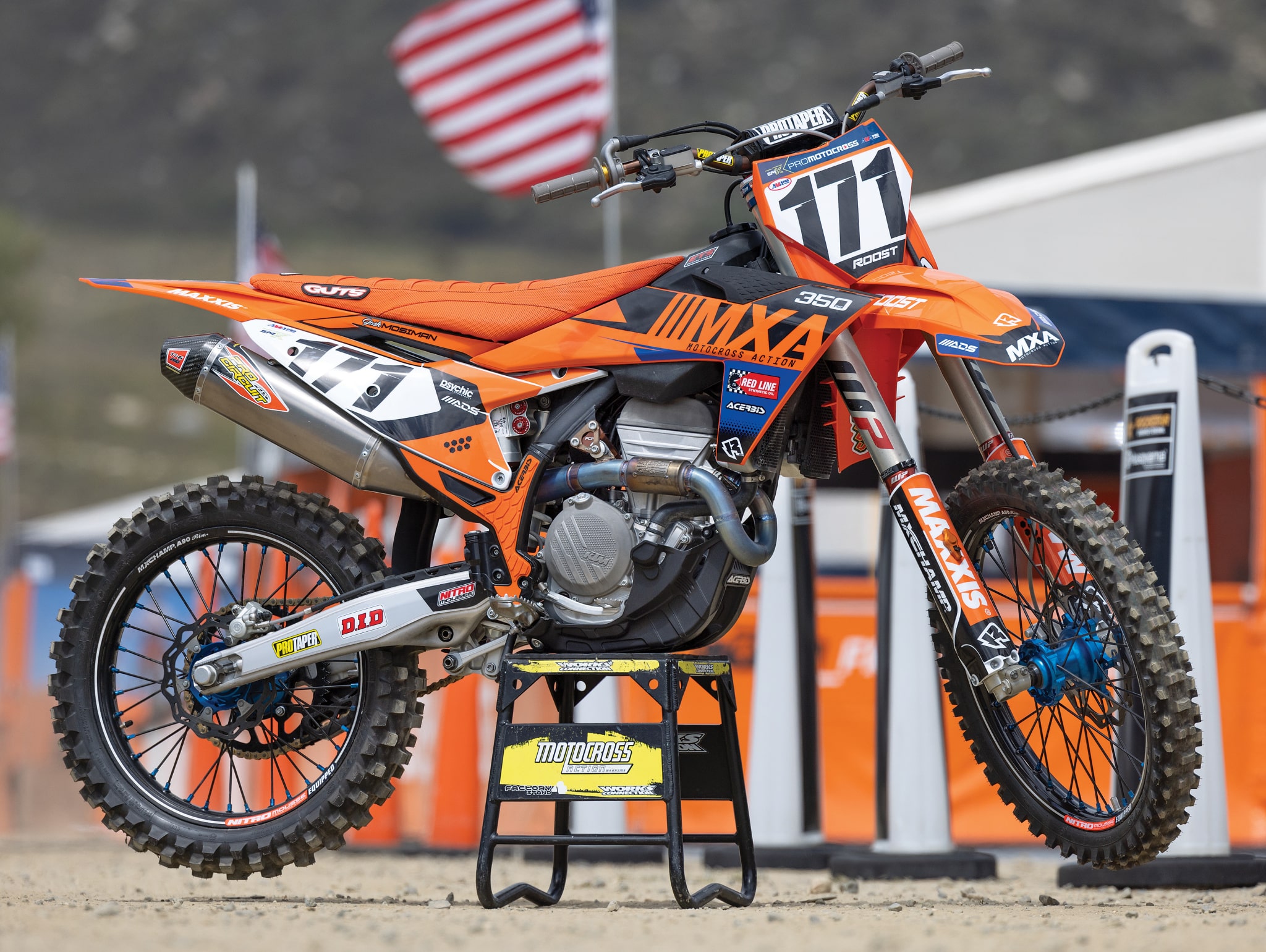 A lot of work went into this 350SXF for just one race.
A lot of work went into this 350SXF for just one race.
BY JOSH MOSIMAN
In 2021 I decided on a whim to race a bone-stock 2022 KTM 450SXF at the Hangtown National. It was challenging, slightly crazy and yet refreshing. It sparked a fire and helped me realize an opportunity. In my position as a test rider and editor for Motocross Action, I have access to all kinds of cool bikes, parts and people—much more than I ever had when I was racing as a full-time AMA Pro. I love to race and I love to tell stories, so why not do both at the highest level? Sure, it’s stressful, but the extra work and stress are self-inflicted.
In 2022, I stepped up big time and raced a Honda CRF450 at Pala, a Kawasaki KX450SR at Hangtown, a Husqvarna FC450 at Washougal, and a KTM 450SXF at Pala II. In 2023, I raced a Yamaha YZ450F at Pala, a GasGas MC450F Factory Edition at Hangtown, and a Honda CRF450 Works Edition at Thunder Valley.
I learned a valuable lesson last year in trying to race three different bikes on three weekends in a row. It was a little too much, and (I hope) I won’t sign up to do that again. This year, I wanted to pick one bike to race at Pala and Hangtown—a bike I thought I could do the best on. After I rode Twisted Development’s 60-horsepower KTM 350SXF, which we tested in the August 2024 issue of MXA, I decided that I wanted to race a 350 at the AMA 450 Nationals. With a lighter crank and much less torque than the 450, the 350SXF engine allows for a nimbler experience on the track. Plus, every time I did a lap-time comparison between the 350 and 450, I was able to push harder and go faster on the 350.
Because Jamie Ellis (owner of Twisted Development) spent his own money on the 60-horsepower 350SXF, and because the Nationals are not kind to motorcycles and their resale value, I didn’t beg Jamie to race his bike. Instead, I snatched MXA’s 2024 KTM 350SXF away from its regular testing duties, and dropped it off at KTM for engine and suspension updates.
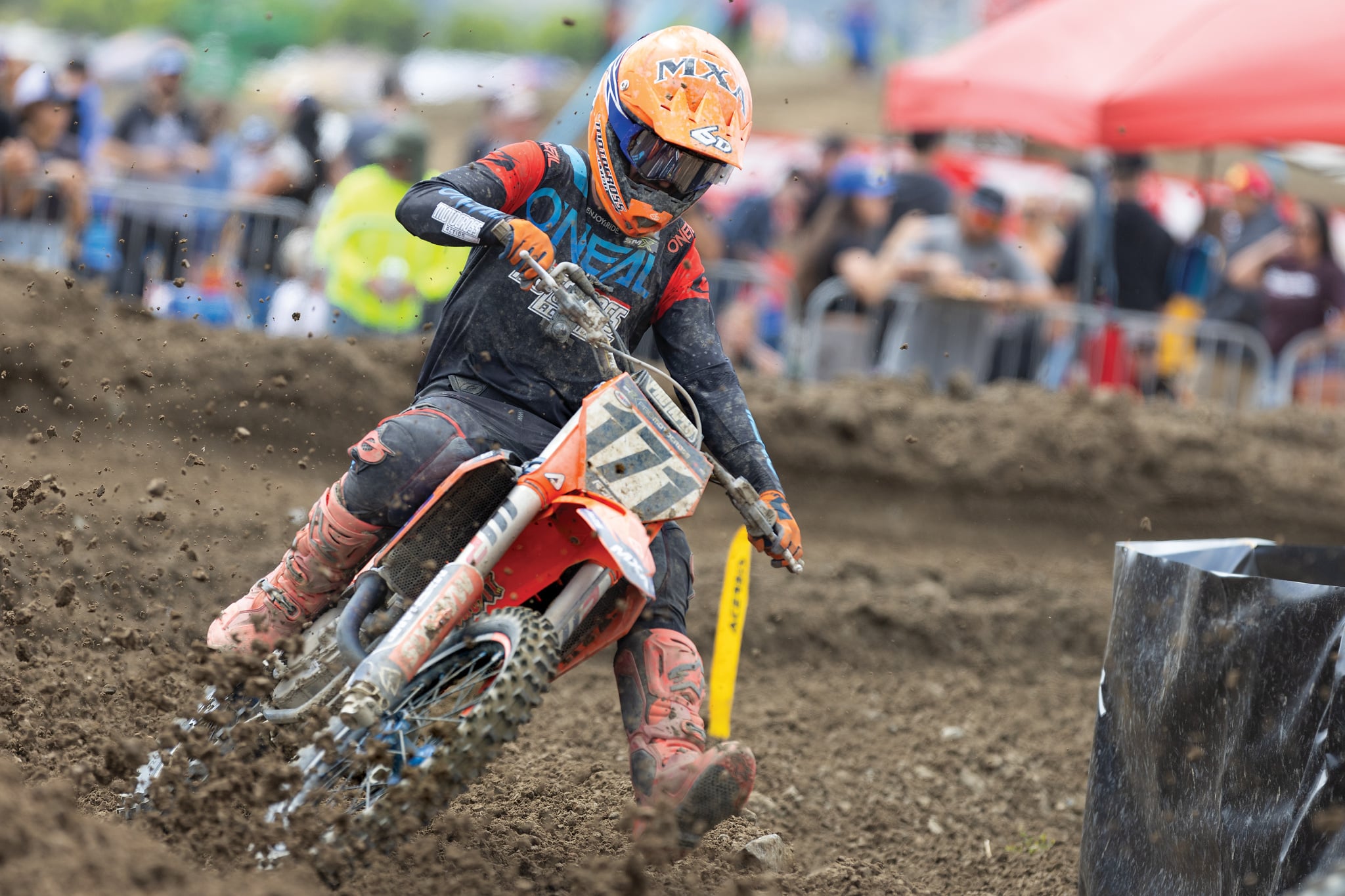 Josh originally planned on racing the 350SXF at Pala and Hangtown, but quickly changed his mind in the middle of the second moto at Pala.
Josh originally planned on racing the 350SXF at Pala and Hangtown, but quickly changed his mind in the middle of the second moto at Pala.
MY PALA RACE BIKE: 2024 KTM 350SXF
The KTM Factory Services crew handled this project front to back, starting with the engine. Leighton Rice has been at KTM since 1998 and has been a first-hand witness of the colossal progress KTM has made since then. He was also in the engine department when KTM first introduced the 350SXF in 2011. At the time, the Austrians believed that everyone would switch to the 350, and they had plans to discontinue their 450. To that end, they had Andrew Short and Mike Alessi racing it full-time in the U.S. and Antonio Cairoli in MXGP. Even Ken Roczen raced the 350SXF in two Supercross rounds in the 450SX class on the East Coast while he was racing a 250SXF in the 250 West Coast Supercross series.
My engine was based on the same 350 engine package that the KTM Factory Service team builds for the factory KTM, Husqvarna and GasGas GNCC riders—who all use 350s. The only difference was that my engine had to be remapped for the ETS MX-21 blend fuel I was using. The factory KTM/Husky/GasGas Supercross and motocross teams all use ETS, but I was surprised to learn the factory GNCC teams, who this engine package was designed for, use VP Racing’s T4 fuel because it’s less expensive and is easier for the Austrians to get for free for their off-road team. I used Pro Circuit’s Ti-6 Pro exhaust. The only difference between the Ti-6 and Ti-6 Pro is additional packing in the muffler to help pass sound testing at the pro races.
Inside the engine, I ran Redline’s 10W40 engine oil and Psychic Racing’s clutch plates. I also used Redline’s coolant, CV4 grease, chain lube and DOT 4 brake fluid to replenish the hydraulics when we bled the Brembo brakes.
As for the suspension, KTM volunteered to set me up with WP Cone Valve forks and a Trax shock setting that is specific to the 350SXF. The overall suspension setup was developed by Damon Conkright and the KTM R&D crew specifically for the components on this bike. This setting is provided to any authorized WP service center as a recommended base setting on the WP Pro Component suspension. I also switched out the stock head stays for aftermarket FCP Racing head stays to help take the edge off the acceleration bumps and help me find a little more traction in the harsh chop.
I don’t mind the stock KTM bars, but I opted to run ProTaper EVO handlebars in their SX Bend. They are a little taller, and I like the extra leverage they give me. I used a ProTaper throttle tube with ProTaper glue-on grips. I switched out the stock triple clamps for Luxon’s Gen3 Pro split triple clamps, which have adjustable offset (21mm, 22mm, 23mm and 24mm). I used them with the stock 22mm position. Luxon also provided the rear axle and rear brake-caliper holder. The caliper holder shaves a little weight, and the rear axle has tighter tolerances than stock (plus, it looks cool).
I used a Guts Racing Wing seat to help me grip the bike with my legs and Acerbis’ frame guards to help me grip the bike with my boots. I also switched to an Acerbis’ Raptor 2 front number plate, which wraps around to protect the Luxon triple clamps from roost, and I mounted an Acerbis skid plate.
I’ve been testing the MX Champ wheels for a few months now and decided to run the black MX Champ A90 rims with their blue hubs and blue spoke nipples to match the blue triple clamps. Mounted on the wheels were Maxxis MX-SI tires and a ProTaper rear sprocket. Maxxis released these tires last year, and I’ve run them for the last two seasons outdoors. The MX-SI front does have a softer carcass than the Dunlop, and I’ve found that increasing tire pressure helps with it. I run 14 psi in the front and 13 psi in the rear. I also used a D.I.D 520MX chain. Your chain is one of the most important safety items on your bike. D.I.D provides chains for a majority of the factory teams, and I feel confident in them because I’ve never had an issue running their chains.
Nitromousse also supported our efforts at the AMA Nationals, and although I didn’t run their mousses on my wheels, the MXA test riders run them at all the off-road events. I have been testing some cool prototype stuff from Nitromousse, and I’m excited about their future. My mechanic and partner in crime Josh Fout did race with Nitromousses in our 2024 Kawasaki KX450 for the amateur day at Hangtown. Of course, I can’t go racing without a Works Connection Pro Launch start device. Additionally, Roost MX graphics tied the whole project together and made me look factory.
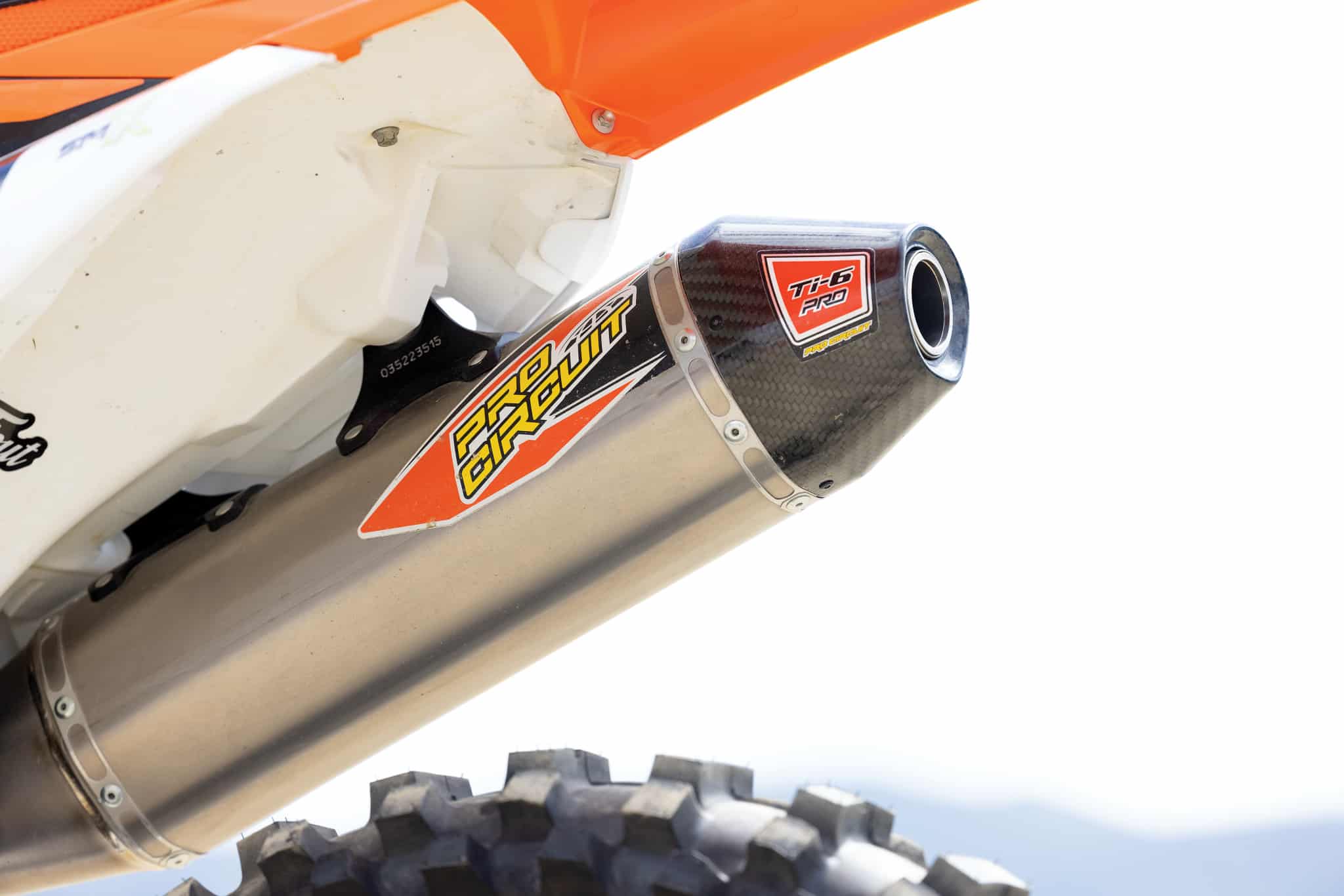 The Pro Circuit Ti-6 Pro exhaust system is built to pass the AMA sound-test requirements for pro racing.
The Pro Circuit Ti-6 Pro exhaust system is built to pass the AMA sound-test requirements for pro racing.
THE PALA NATIONAL IN A NUTSHELL
Coming into Pala, I had fewer nerves than normal. I had raced Glen Helen’s Stopwatch National Pro Motocross warm-up race one week prior on the 350SXF, and I did great! It was two 30-minute motos at Glen Helen on their fully prepped National track. Despite bad starts, I impressed myself with how well I rode and with how many guys I passed late in the motos. This boosted my confidence for Pala. I was excited to rev out the 350SXF and see how it would handle in the “big show.”
When it came time to hit the track for Pala qualifying, the track crew had changed the program without warning. Instead of letting all the riders go at once and jockey for qualifying position, they lined us up on the gate and sent us out one by one, from inside of the gate first to the outside of the gate last. I didn’t know about the change until it was too late and ended up buried in the pack, which wasn’t beneficial for timed qualifying. I always like to find a clear track to lay down a fast lap, and it’s hard to do that when you’re mid-pack. They didn’t rip the track as deep or water as much as they have in years past, but it was still challenging. I wasn’t smooth in the corners, and I was stuffing the 350 into the ruts, not carrying momentum like I was at Glen Helen the week prior. At this point, I was frustrated but not second-guessing my bike choice.
In the second session, I learned my lesson and got down to the starting line early so I could be on the inside gate and get out in front for a clear track. I improved my time, but it still wasn’t enough to make the top 36 times. I had to go to the Last Chance Qualifier (LCQ) to get into the show the hard way. This was only the second time in my pro career that I had to go to the LCQ at a National. It was not a good feeling! When the gate dropped, I was able to get a top-10 start, make some quick passes on the first lap, and dodge a few wrecks to finish fourth, which was the final transfer position into the National. Even at this point, I still wasn’t upset with my 350 decision. I figured once the real racing started, my “nimble 350” would shine.
With a last-place gate pick, I lined up on the very outside gate, which surprisingly turned out to be a blessing. I held it on around the outside, dodged a big first-turn crash, and was in 20th place across the finish line on the first lap! I was happy to have made up 20 spots from my 40th gate pick. I bounced around for the first four laps and stayed in the 19th–20th position until about 10 minutes into the 30-minute moto. At that point, everyone else picked up the pace while I started losing it. By the end of the race, I was in 37th place. Yep, that was my worst finish in a National moto—except for one I crashed out of and one I had mechanical problems in. After talking to Josh Fout and Dennis Stapleton in between motos, it finally started to hit me: there is a reason no KTM factory riders race a 350SXF at the Nationals.
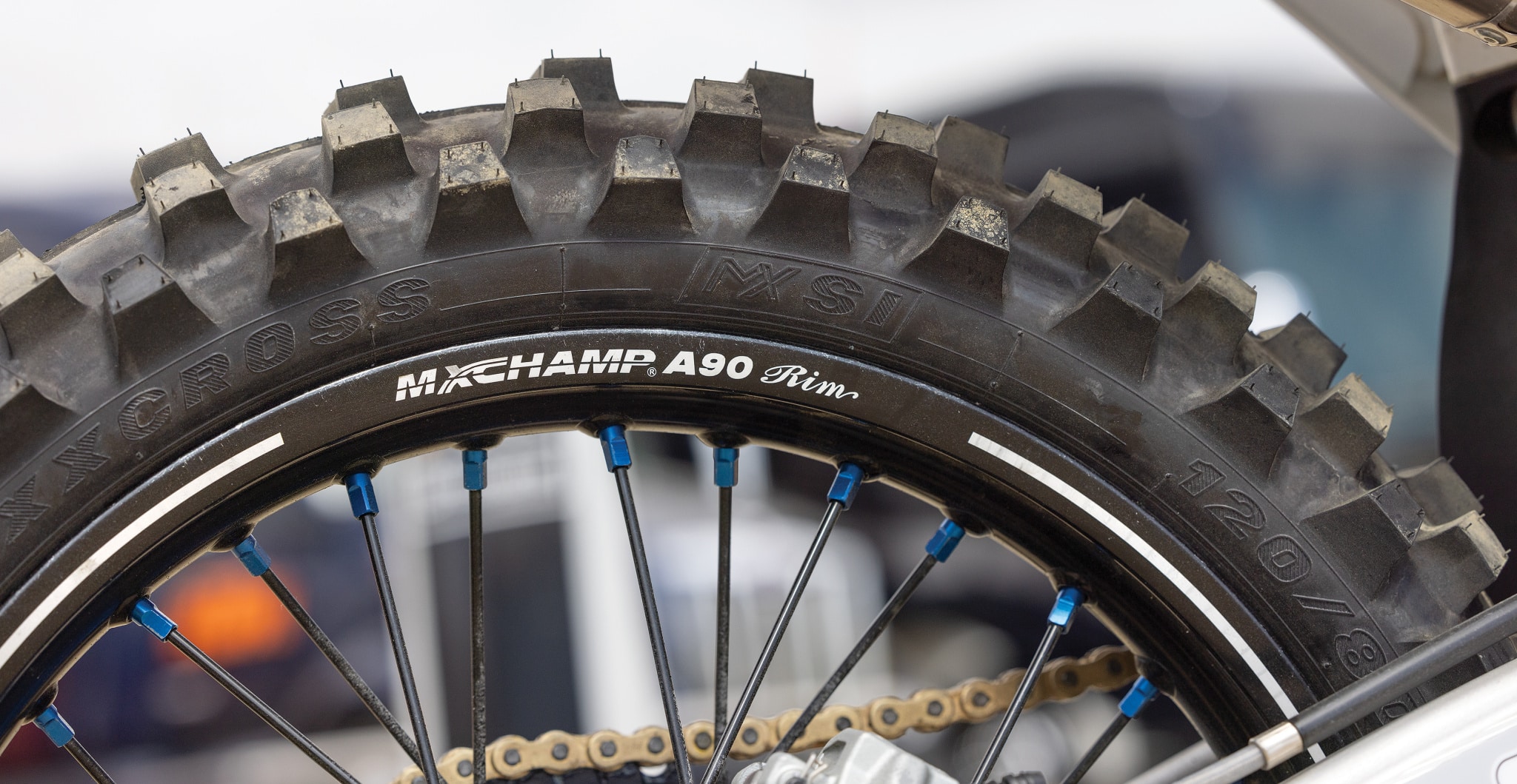 Josh used Maxxis MX-SI “soft intermediate” tires and MX Champ wheels with their own proprietary A90 rims. They held up strong at both Nationals.
Josh used Maxxis MX-SI “soft intermediate” tires and MX Champ wheels with their own proprietary A90 rims. They held up strong at both Nationals.
Moto two was more of the same story, only I was farther back on the opening laps. In both races, I was patiently waiting for the 350 to start showing the agility and high-rpm power that it had shown in my warm-up races. I had expected it to propel me forward through the pack when my 450-mounted competitors started to fade; instead, I was the one who faded.
Of course, the 350SXF was never completely to blame. It ran strong all day without a single issue, but I wasn’t able to ride it the way it needed to be ridden. The same guys I passed late in the motos at Glen Helen’s Stopwatch National the week prior qualified 10 spots ahead of me and finished 10 spots ahead of me.
Why couldn’t I run with them at Pala? It came down to two things: track condition and mental position. AMA National prep is always deeper, rougher and more rutted than local racetracks, which made it harder to find smooth lines than it was the week prior at Glen Helen. Of course, Glen Helen wasn’t smooth, but it’s my local track. MXA test riders call it our “dirt dyno.” I know the track like the back of my hand, and because of that I could manhandle the 350SXF and push it with more familiarity. Of course, I’ve ridden at Pala a million times, too, but the National track had incredibly deep ruts on the corner exit, where the snappy acceleration of the 450s outclassed the mellower low-end thrust of the 350. What I’d make up on the open parts of the track, I’d lose in the first 10 feet out of every corner. Of course, I knew this going in, because everyone told me that would happen in the corners. I just expected to make up for it with the lighter-feeling, faster-revving and easier-to-ride 350 powerplant.
Significantly, I wasn’t the same rider at Pala. When the factory teams pulled into the parking lot, the track crew started hanging banners around the course, and the fans started lining the fences, something happened to me mentally. The nerves kicked in and self-doubt followed. Because of that, all day at Pala I was holding on tighter, letting off sooner and second-guessing my decisions all the way around the track. Subconsciously, it’s hard to let loose and ride to your potential when the pressure is on, even if I’m the one putting pressure on myself. This attitude/mental state leads to more mistakes. Riding a 350SXF makes it harder to recover from mistakes.
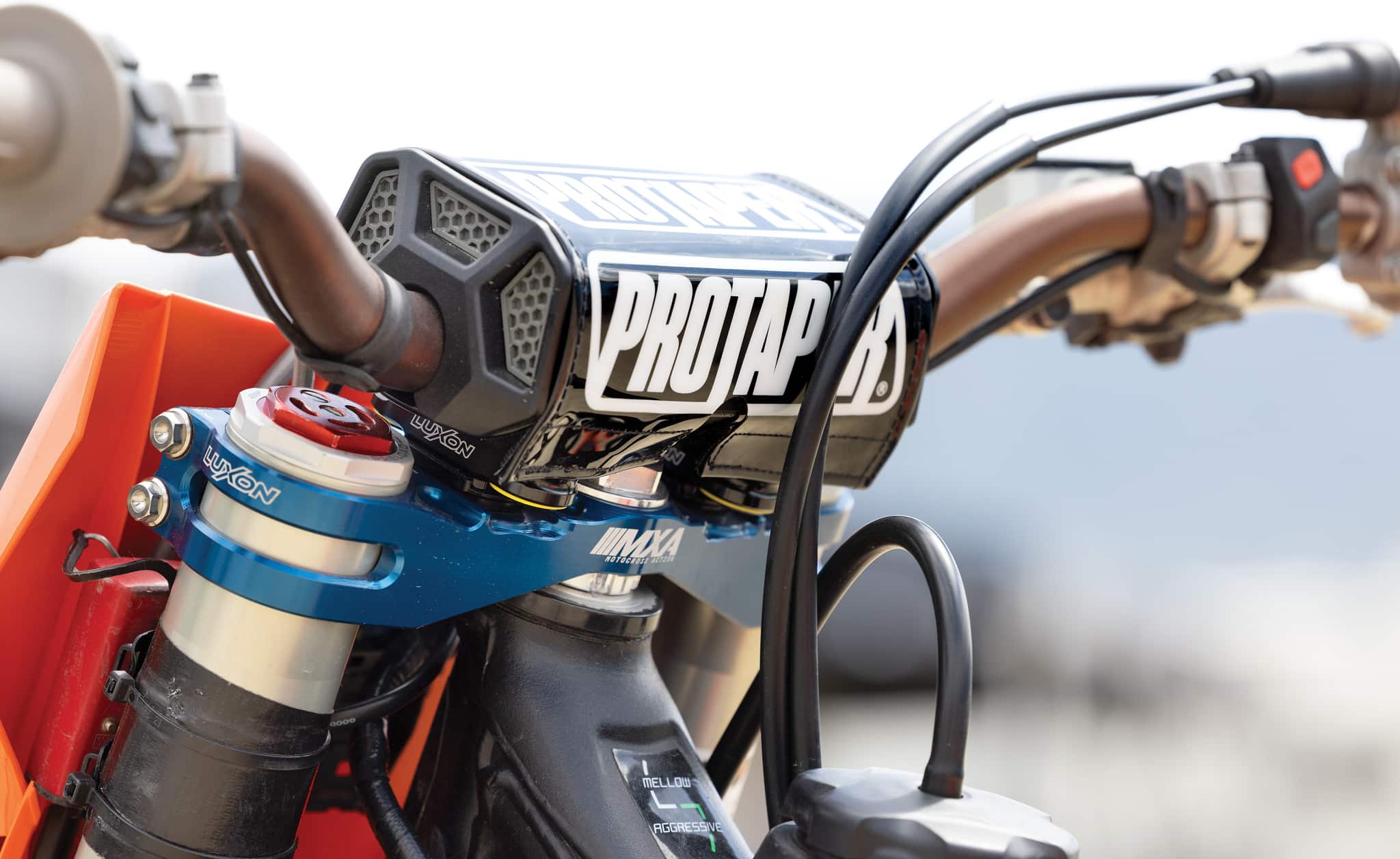 Josh ran the ProTaper SX bend handlebars with glue-on, medium durometer grips.
Josh ran the ProTaper SX bend handlebars with glue-on, medium durometer grips.
MY HANGTOWN RACE BIKE: 2024-1/2 KTM 450SXF FACTORY EDITION
After Pala, I decided to switch to our 2024-1/2 KTM 450SXF Factory Edition for Hangtown. I figured this would confirm whether my struggles in timed qualifying and poor results in the motos were due to being down 100cc or if it was really just rider error.
Switching to the 450 wasn’t a hard process. I had been racing on this bike for the past three months leading up to the 2024 AMA 450 Nationals, so it was familiar territory for me. The big difference was that I was using MX-Tech suspension on this bike, with their Blackjack forks and National shock. The Blackjack forks are spring forks, so they are heavier than the stock WP air forks, but they’re lighter than the WP cone valves, which I like.
Besides the suspension, most everything I had on the 350 transferred over to the 450 Factory Edition for Hangtown. I didn’t even bother Roost MX with sending new graphics that said “450” on them. Our photographer, Trevor Nelson, thought it would be funnier to Sharpie “450” on one side of the shrouds and write “not a 350” on the other side. I did run the stock head pipe with the Akropovic muffler that comes on the Factory Edition to match the stock engine. Also, I used the KTM Powerparts holeshot device that was already set up for the MX-Tech forks, but otherwise the bike was configured very much the same as the 350SXF.
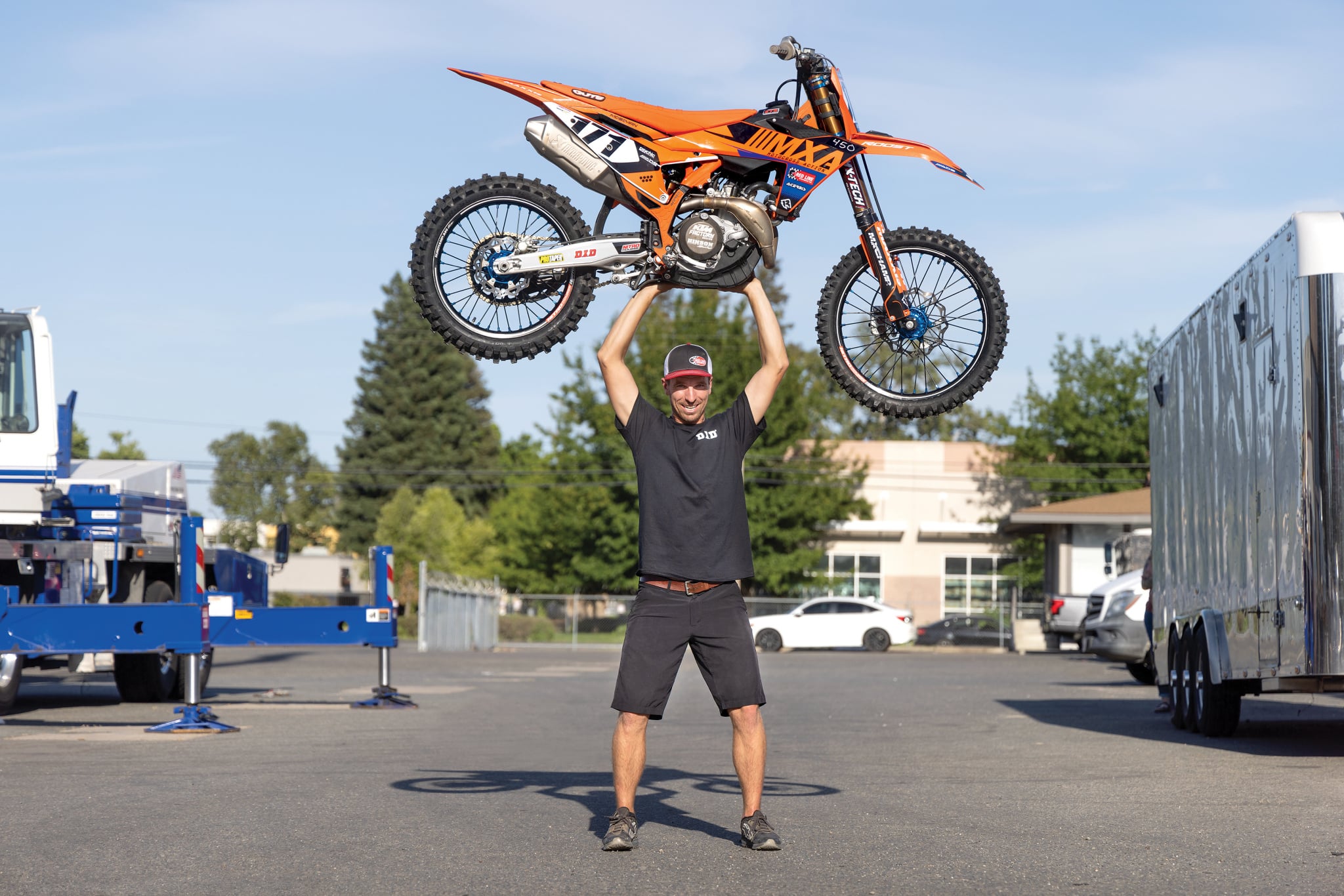 Is the KTM 450SXF that light? Or, is Josh that strong? Our YouTube video from Hangtown will give more context to this photo.
Is the KTM 450SXF that light? Or, is Josh that strong? Our YouTube video from Hangtown will give more context to this photo.
HANGTOWN NATIONAL & MY BIG CRASH
Hangtown started off on the wrong foot! I had a “big one” on lap two of the first qualifying session. The track wasn’t ripped as deeply as normal, but there was one rhythm lane that was deep, muddy and rutted between the jumps. I rolled through it on the first lap, which is meant to be a sight lap with no jumping, and then I picked up the pace on lap two once the green flag waved. Qualifying is the most stressful time at a National, and after qualifying 39th and having to go through the LCQ at Pala, I was dead set on that not happening again.
Well, my eagerness bit me. I trusted the soft stuff too much, and when I landed in the deep, rutted and muddy swamp between jumps, my bike swapped and kicked me off. Without video footage, I would’ve thought I went straight over the bars because it happened so fast. Flying through the air, I had enough time to think, “I’m done for the day.” But, once I hit the dirt, I bounced to my feet quickly and knew the day wasn’t over; it just got a lot harder.
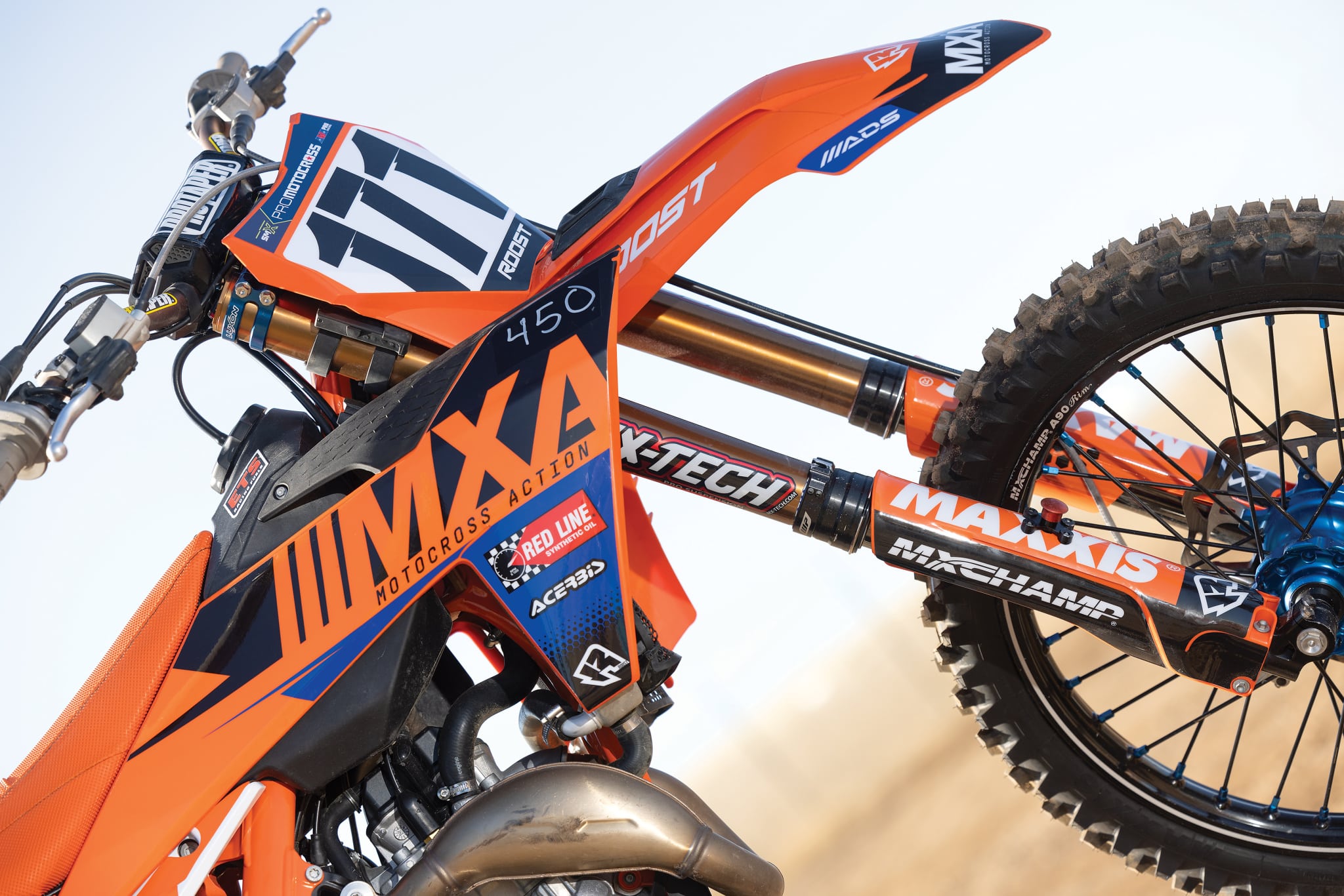 Josh ran MX-Tech suspension on the 2024-1/2 KTM 450SXF Hangtown race bike.
Josh ran MX-Tech suspension on the 2024-1/2 KTM 450SXF Hangtown race bike.
The front end was twisted and the front brake lever was bent down and packed with mud, but the bars themselves weren’t bent. I pulled into the mechanics’ area for about four minutes as Josh Fout straightened it out. With three laps left in the first timed qualifying session, I went all-out, knowing that I had to give it my best shot to make the motos. It was not to be a fairy-tale ending. I ended up 39th overall after the first 450 Group A timed session, which wasn’t going to be good enough to qualify.
I was nervous for session two, but talking to friends and fans in between qualifying sessions kept my mind off it! Hangtown is a homecoming race for me. I grew up riding there and lived in the town of Sebastopol about two and a half hours away. Seeing familiar faces, as well as meeting lots of new ones who follow MXA, was a real treat. It helped me keep perspective, remembering why I was out there risking life and limb. I have a unique job with a great opportunity to share exciting experiences with people who read our magazine and watch our videos—hopefully inspiring others to get out of their comfort zone and hit the track themselves.
Session two couldn’t have gone any better! Josh Fout brought my bike to staging early to make sure we got the first gate on the inside so I could be the first one on the track. Aaron Plessinger liked my idea and started right behind me, passing me on the first lap. This allowed me to hook on a tow rope and follow his lines around the track. The track was more broken in than the first session, but it wasn’t insanely rough like it could have been if they had watered more and ripped the track deeper. It was developing nicely, and thanks to Aaron Plessinger’s tow rope, I was able to improve my lap time from the first session by over three seconds! This was good enough for a 26th out of a total of 81 guys who showed up to qualify. It was something I could hang my hat on.
The track at Hangtown was really cool this year. The Dirt Diggers Club has hosted the Hangtown National for 55 years, and this was the first time they hired out the track design/layout to an outside designer—Shane Schaefer of Schaefer Tracks. He made the track wider, made the jumps bigger, changed the layout and brought in a couple hundred truckloads of sand. The jumps were definitely on the big side, but they were well-built. The lips didn’t rut up or form kickers, which made them safer. The uphill roller section was tough! There was a double in the middle that was technical. The main line was to jump off a small lip, over a taller/steeper landing. It was hard to get enough pop off the lip to make the downside without clipping the top of the landing (not to mention there were ruts all the way across the lip). If you did it right, it was fast. If you messed up, you lost a lot of time and energy hammering into the rest of the uphill rollers.
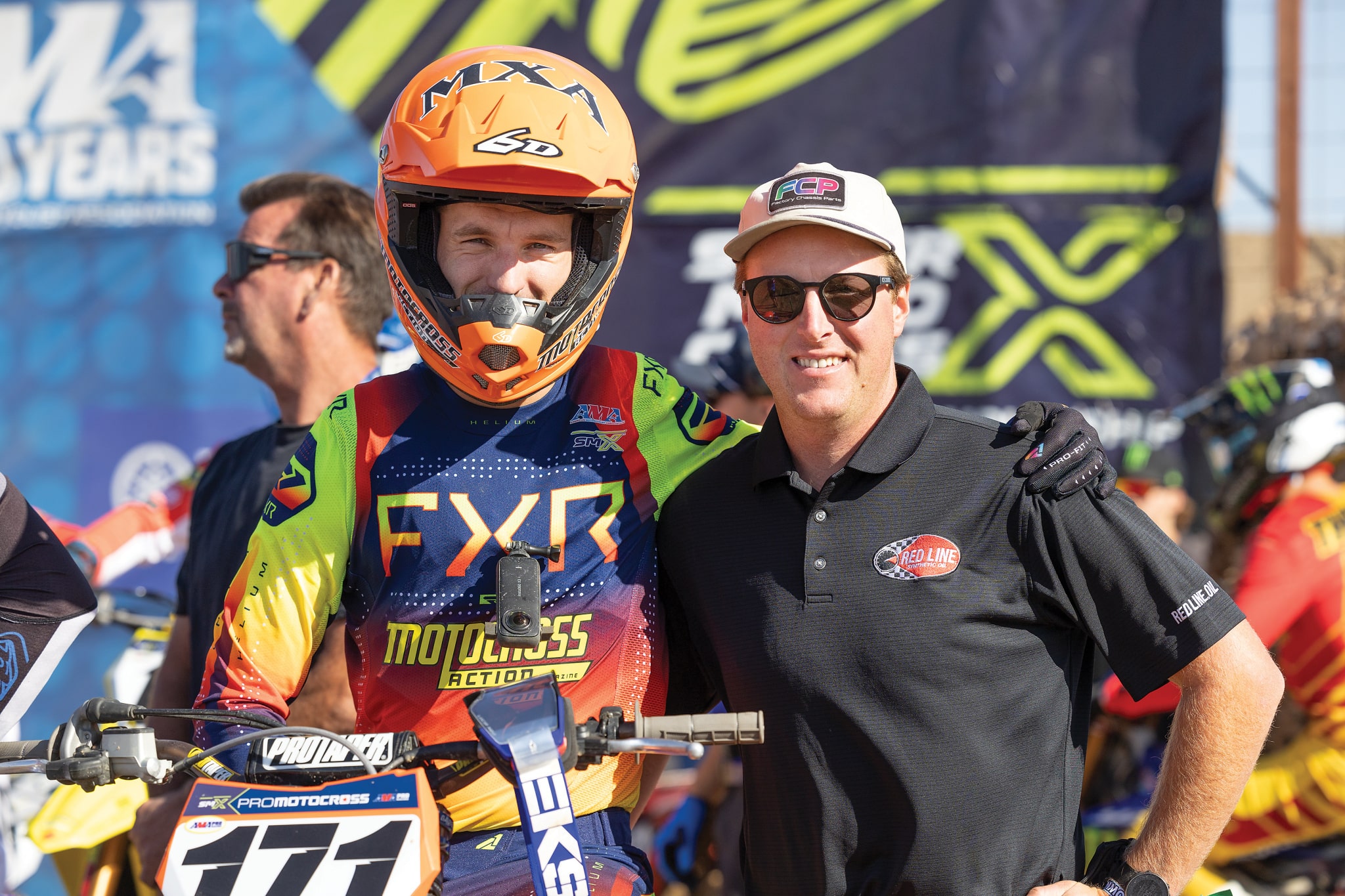
Of course, the other roller/rhythm lane where I crashed earlier in the day was mentally tougher for me than for the other guys who hadn’t crashed there. Thankfully, it dried out for the motos, but it was still rutted in between the jumps, making me anxious when I hit that section every lap.
The trucked-in sand was mostly placed on the downhills, but they did scatter some of it on the second turn of the start and the corner after the mechanics’ area (before the amateur finish-line jump). The rest of the track developed with a harder base and more solid ruts, but those sandier sections felt a lot more like an East Coast track, with softer bumps and ruts developing and changing throughout the motos.
Compared to Pala, my starts were considerably better on the 450. At Pala, I qualified 39th (the top 36 go directly to the motos) and was relegated to the 40th gate pick by finishing fourth in the LCQ. Then I went 37-37 in the motos on the 350SXF at Pala. At Hangtown, I qualified 26th and went 32-34. In my eyes, I believe I should have placed a lot better. There were guys I’ve beaten recently who were far ahead of me in the results; however, there were also multiple riders who’ve consistently beaten me over the last few months (in the local races I did to prepare for the Nationals) who didn’t even qualify at Pala or Hangtown. Something happens on race day. Some riders rise to the occasion, and others crumble under the pressure. I landed somewhere in between on that spectrum.
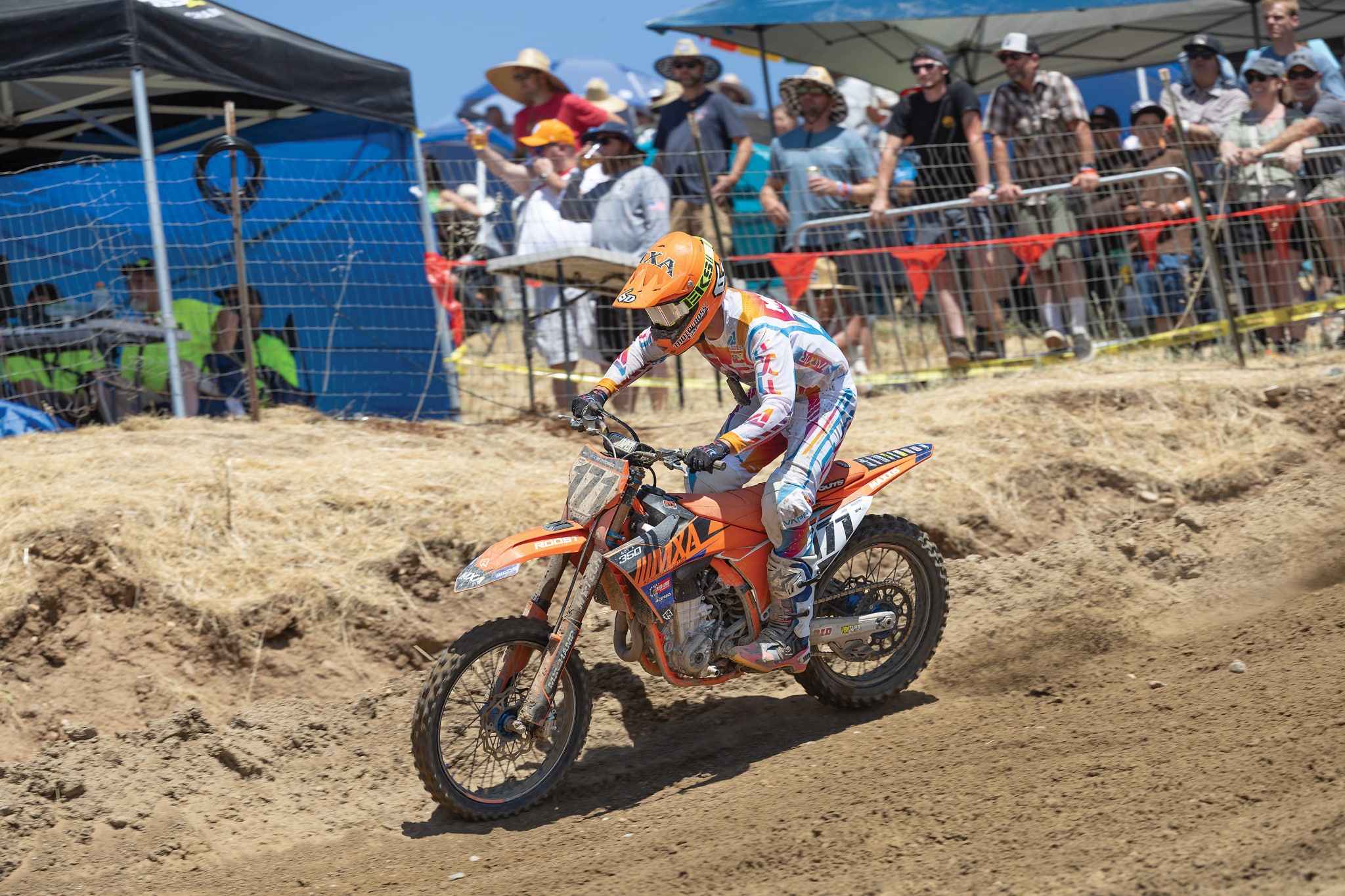 On the radiator wing of the 450SXF at Hangtown, Trevor wrote, “NOT A 350,” so that Josh could use the same graphics that he had at Pala when it was a 350SXF.”
On the radiator wing of the 450SXF at Hangtown, Trevor wrote, “NOT A 350,” so that Josh could use the same graphics that he had at Pala when it was a 350SXF.”
THE BIG TAKEAWAY!
The big takeaway was that I finally solved the age-old 350-versus-450 riddle for myself. Even though I can make a 350 go fast at a local pro race, I’m much better off on a 450 when it comes time to race at the highest level. Still, I’m a huge fan of the 350 platform and recommend it highly to anyone riding or racing at the local level. It is, in MXA’s opinion, the best all-around motocross bike made for the widest range of skills.







Comments are closed.